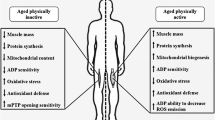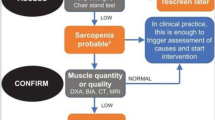Abstract
The precise cause of sarcopenia, skeletal muscle loss and strength, in older persons is unknown. However, there is a strong evidence for muscle loss due to insulin resistance as well as mitochondrial dysfunction over aging. Considering that epidemiological studies have underlined that insulin resistance may have a specific role on skeletal muscle fibre atrophy and mitochondrial dysfunction has also been extensively shown to have a pivotal role on muscle loss in older persons, a combined pathway may not be ruled out. Considering that there is growing evidence for an insulin-related pathway on mitochondrial signaling, we hypothesize that a high degree of insulin resistance will be associated with the development of sarcopenia through specific alterations on mitochondrial functioning. This paper will highlight recent reviews regarding the link between skeletal muscle mitochondrial dysfunction and insulin resistance. We will specifically emphasize possible steps involved in sarcopenia over aging, including potential biomolecular mechanisms of insulin resistance on mitochondrial functioning.
Similar content being viewed by others
References
Abbatecola AM, Ferrucci L, Ceda G, Russo CR, Lauretani F, Bandinelli S, Barbieri M, Valenti G, Paolisso G. (2005) Insulin resistance and muscle strength in older persons. J Gerontol A Biol Sci Med Sci;60(10):1278–1282.
Park SW, Goodpaster BH, Lee JS, Kuller LH, Boudreau R, de Rekeneire N, Harris TB, Kritchevsky S, Tylavsky FA, Nevitt M, Cho YW, Newman AB; Health, Aging, and Body Composition Study (2009) Excessive loss of skeletal muscle mass in older adults with type 2 diabetes. Diabetes Care;32(11):1993–1997
Wang M, Wang XC, Zhang ZY, Mou B, Hu RM. (2010) Impaired mitochondrial oxidative phosphorylation in multiple insulin-sensitive tissues of humans with type 2 diabetes mellitus. J Int Med Res;38(3):769–781.
Ritov VB, Menshikova EV, Azuma K, Wood R, Toledo FG, Goodpaster BH, Ruderman NB, Kelley DE. (2010) Deficiency of electron transport chain in human skeletal muscle mitochondria in type 2 diabetes mellitus and obesity. Am J Physiol Endocrinol Metab;298(1):E49–E58
Lennmarken C, Bergman T, Larsson J, Larsson L-E. (1985) Skeletal muscle function in man: force, relaxation rate, endurance and contraction time-dependence on sex and age. Clin Physiol;5:243–255.
Jubrias SA, Odderson IR, Esselman PC, Conley KE. (1997) Decline in isokinetic force with age: muscle cross-sectional area and specific force. Arch Eur J Physiol;434:246–253
Wolfson L, Judge J, Whipple R, King M. (1995) Strength is a major factor in balance, gait, and the occurrence of falls. J Gerontol;50A:64–68.
Evans WJ, Cyr-Campbell D. (1997) Nutrition, exercise, and healthy aging. J Am Diet Assoc;97(6):632–638.
Mokdad AH, Ford ES, Bowman BA, et al. (2003) Prevalence of obesity, diabetes and obesity-related risk-factors. JAMA; 289:76–79.
Short KR, Bigelow ML, Kahl J, Singh R, Coenen-Schimke J, Raghavakaimal S, Nair KS (2005) Decline in skeletal muscle mitochondrial function with aging in humans. Proc Nat Acad Sci USA;102(15):5618–5623.
Song XM, Ryder JW, Kawano Y, Chibalin AV, Krook A, Zierath JR (1999) Muscle fiber type specificity in insulin signal transduction. Am J Physiol;277(6 Pt 2):R1690–1696.
Lexell J, Henriksson-Larsen K, Wilblad B, Siostrom M. (1983) Distribution of aging studied in whole muscle cross-sections. Muscle Nerve; 6:588–595.
Madsen OR, Lauridsen UB, Hartkopp A, Sorensen OH (1997) Muscle strength and soft tissue composition as measured by dual energy x-ray absorptiometry in women aged 18–87 years. Eur J Appl Physiol Occup Physiol;76:239–245.
Cesari M, Leeuwenburgh C, Lauretani F, Onder G, Bandinelli S, Maraldi C, Guralnik JM, Pahor M, Ferrucci L. (2006) Frailty syndrome and skeletal muscle: results from the Invecchiare in Chianti study. Am J Clin Nutr;83(5):1142–1148.
Rolland Y, Czerwinski S, Abellan Van Kan G, Morley JE, Cesari M, Onder G, Woo J, Baumgartner R, Pillard F, Boirie Y, Chumlea WM, Vellas B. (2008) Sarcopenia: its assessment, etiology, pathogenesis, consequences and future perspectives. J Nutr Health Aging;12(7):433–450
Boncompagni S, d’Amelio L, Fulle S, Fanò G, Protasi F (2006) Progressive disorganization of the excitation-contraction coupling apparatus in aging human skeletal muscle as revealed by electron microscopy: a possible role in the decline of muscle performance. J Gerontol A Biol Sci Med Sci;61(10):995–1008.
Aiken J, Bua E, Cao Z, Lopez M, Wanagat J, et al. (2002) Mitochondrial DNA deletion mutations and sarcopenia. Ann N Y Acad Sci;959:412–423.
Bua E, Johnson J, Herbst A, Delong B, McKenzie D, et al. (2006) Mitochondrial DNA-deletion mutations accumulate intracellularly to detrimental levels in aged human skeletal muscle fibers. Am J Hum Genet;79:469–480.
Bua EA, McKiernan SH, Wanagat J, McKenzie D, Aiken JM. (2002) Mitochondrial abnormalities are more frequent in muscles undergoing sarcopenia. J Appl Physiol;92:2617–2624.
Wanagat J, Cao Z, Pathare P, Aiken JM. (2001) Mitochondrial DNA deletion mutations colocalize with segmental electron transport system abnormalities, muscle fiber atrophy, fiber splitting, and oxidative damage in sarcopenia. Faseb J;15:322–332.
Hsieh RH, Hou JH, Hsu HS, Wei YH. (1994) Age-dependent respiratory function decline and DNA deletions in human muscle mitochondria. Biochem Mol Biol Int;32:1009–1022
Trounce I, Byrne E, Marzuki S. (1989) Decline in skeletal muscle mitochondrial respiratory chain function: possible factor in ageing. Lancet;1:637–639.
Barrientos A, Casademont J, Rotig A, Miro O, Urbano-Marquez A, et al. (1996) Absence of relationship between the level of electron transport chain activities and aging in human skeletal muscle. Biochem Biophys Res Commun;229:536–539.
Parise G, Kaczor J, Mahoney J, Phillips S, Tarnopolsky M (2004). Oxidative stress and the mitochondrial theory of aging in human skeletal muscle. Experimental Gerontology;39:1391–1400.
Castillo EM, Goodman-Gruen D, Kritz-Silverstein D, Morton DJ, Wingard DL, Barrett-Connor E. (2003) Sarcopenia in elderly men and women: the Rancho Bernardo study. Am J Prev Med;25(3):226–231.
Hoeks J, van Herpen NA, Mensink M, Moonen-Kornips E, van Beurden D, Hesselink MK, Schrauwen P. (2010) Prolonged fasting identifies skeletal muscle mitochondrial dysfunction as consequence rather than cause of human insulin resistance. Diabetes;59(9):2117–21
Barazzoni R, Short KR, Nair KS. (2000) Effects of aging on mitochondrial DNA copy number and cytochrome c oxidase gene expression in rat skeletal muscle, liver and heart. J Biol Chem;275:3343–3347.
Huang X, Eriksson K-F, Vaag A, et al. (1999) Insulin-regulated mitochondrial gene expression is associatedwith glucose flux in human skeletal muscle. Diabetes;48:1508–1514.
Huang X, Eriksson K-F, Vaag A, et al. (1999) Insulin-regulated mitochondrial gene expression is associated with glucose flux in human skeletal muscle. Diabetes; 48:1508–1514.
Stump CS, Short KR, Bigelow ML, et al. (2003) Effect of insulin on human skeletal muscle mitochondrial ATP production, protein synthesis, and mRNA transcripts. Proc Natl Acad Sci USA; 100:7996–8001.
Boirie Y, Short KR, Ahlman B, et al. (2001) Tissue-specific regulation of mitochondrial and cytoplasmic protein synthesis rates by insulin. Diabetes;50:2652–2658.
Petersen KF, Befroy D, Dufour S, Dziura J, Ariyan C, Rothman DL, DiPietro L, Cline GW, Shulman GI. (2003) Mitochondrial dysfunction in the elderly: possible role in insulin resistance. Science;300(5622):1140–1142.
Mootha V, Lindgren CM, Eriksson KF et al. (2003) PGC-1alpha-responsive genes involved in oxidative phosphorylation are coordinately downregulated in human diabetes. Nat. Genet. 34, 267–273
Patti M, Butte AJ, Crunkhorn S et al. (2003) Coordinated reduction of genes of oxidative metabolism in humans with insulin resistance and diabetes: Potential role of PGC1 and NRF1. Proc. Natl. Acad. Sci. U. S. A. 100, 8466–8471)
Ritov VB, Menshikova EV, He J, Ferrell RE, Goodpaster BH, Kelley DE (2005) Deficiency of subsarcolemmal mitochondria in obesity and type 2 diabetes. Diabetes 54, 8–14 12).
Barletta, A., and Liverini, G. (2003) Effect of high-fat feeding on metabolic efficiency and mitochondrial oxidative capacity in adult rats. Br. J. Nutr. 90, 953–960
Bonnard C, Durand A, Peyrol S, Chanseaume E, Chauvin MA, Morio B, Vidal H, Rieusset J. (2008) Mitochondrial dysfunction results from oxidative stress in the skeletal muscle of diet-induced insulin-resistant mice. J Clin Invest;118(2):789–800.
Hancock, C. R., Han, D. H., Chen, M., Terada, S., Yasuda, T., Wright, D. C, Holloszy, J. O. (2008) High-fat diets cause insulin resistance despite an increase in muscle mitochondria. Proc. Natl. Acad. Sci. USA 105, 7815–7820.
Short KR, Vittone JL, Bigelow ML, Proctor DN, Rizza RA, Coenen-Schimke JM, Nair KS (2003) Impact of aerobic exercise training on age-related changes in insulin sensitivity and muscle oxidative capacity. Diabetes;52(8):1888–1896
Dumas JF, Simard G, Flamment M, Ducluzeau PH, Ritz P (2009) Is skeletal muscle mitochondrial dysfunction a cause or an indirect consequence of insulin resistance in humans? Diabetes Metab;35(3):159–167
Anderson EJ, Lustig ME, Boyle KE, et al. (2009) Mitochondrial H2O2 emission and cellular redox state link excess fat intake insulin reisistance in both rodents and humans, J Clin Invest 119: 573–581
Han DH, Hancock CR, Jung SR, Higashida K, Kim SH, Holloszy JO. (2011) Deficiency of the mitochondrial electron transport chain in muscle does not cause insulin resistance. PLoS One;6(5):e19739.
Morino K, Petersen KF, Shulman GI (2006) Molecular mechanisms of insulin resistance in humans and their potential links with mitochondrial dysfunction. Diabetes 55: S9–S15
Chattopadhyay M, Guhathakurta I, Behera P, Ranjan KR, Khanna M, Mukhopadhyay S, Chakrabarti S. (2011) Mitochondrial bioenergetics is not impaired in nonobese subjects with type 2 diabetes mellitus. Metabolism.
Goodpaster BH, Thaete FL, Simoneau JA, Kelley DE. (1997) Subcutaneous abdominal fat and thigh muscle composition predict insulin sensitivity independently of visceral fat. Diabetes; 46: 1579–1585.
Torriani M, Hadigan C, Jensen ME, Grinspoon S. (2003) Psoas muscle attenuation measurement with computed tomography indicates intramuscular fat accumulation in patients with HIV-lipodystrophy syndrome. J Appl Physiol;95: 1005–1101
Goodpaster BH, Carlson CL, Visser M, Kelley DH, Scherzinger A, Harris TB, Stamm E, Newman AB. (2001) Attenuation of skeletal muscle and strength in the elderly. The Health ABC study. J Appl Phsiol;90: 2157–2165
Abbatecola AM, Chiodini P, Gallo C, Lakatta E, Sutton-Tyrrell K, Tylavsky FA, Goodpaster B, de Rekeneire N, Schwartz AV, Paolisso G, Harris T; for the Health ABC study (2011) Pulse wave velocity is associated with muscle mass decline: Health ABC study. Age (Dordr).
Lowell BB, Shulman GI. Mitochondrial dysfunction and type 2 diabetes. Science. 2005;307(5708):384–387.
Riedl I, Yoshioka M, St-Amand J. Concomitant modulation of transcripts related to fiber type determination and energy metabolism in skeletal muscle of female ovariectomized mice by estradiol injection. J Steroid Biochem Mol Biol. 2010 Oct;122(1–3):91–99
Kane DA, Lin CT, Anderson EJ, Kwak HB, Cox JH, Brophy PM, Hickner RC, Neufer PD, Cortright RN. Progesterone increases skeletal muscle mitochondrial H2O2 emission in nonmenopausal women. Am J Physiol Endocrinol Metab. 2011 Mar;300(3):E528–E535)
Borst SE. Interventions for sarcopenia and muscle weakness in older people. Age Ageing. 2004;33(6):548–555.
Corcoran MP, Lamon-Fava S, Fielding RA. (2007) Skeletal muscle lipid deposition and insulin resistance: effect of dietary fatty acids and exercise. Am J Clin Nutr;85(3):662–677.
Simoneau JA, Kelley DE.(1997) Altered glycolytic and oxidative capacities of skeletal muscle contribute to insulin resistance in NIDDM. J Appl Physiol 83:166–171
Trappe SW, Costill DL, Fink WJ, Pearson DR. (1995) Skeletal muscle characteristics among distance runners: a 20-yr follow-up study. J Appl Physiol; 78:823–828
Brehm A, Krssak M, Schmid AI, Nowotny P, Waldhäusl W, Roden M. (2006) Increased lipid availability impairs insulin-stimulated ATP synthesis in human skeletal muscle. Diabetes;55(1):136–140.
Fleischman A, Johnsen S, Systrom DM, et al. (2007) Effects of a nucleoside reverse transcriptase inhibitor, stavudine, on glucose disposal and mitochondrial function in muscle of healthy adults. Am J Physiol Endocrinol Metab.;292(6):E1666–E1673.
Author information
Authors and Affiliations
Corresponding author
Rights and permissions
About this article
Cite this article
Abbatecola, A.M., Paolisso, G., Fattoretti, P. et al. Discovering pathways of sarcopenia in older adults: A role for insulin resistance on mitochondria dysfunction. J Nutr Health Aging 15, 890–895 (2011). https://doi.org/10.1007/s12603-011-0366-0
Received:
Accepted:
Published:
Issue Date:
DOI: https://doi.org/10.1007/s12603-011-0366-0




